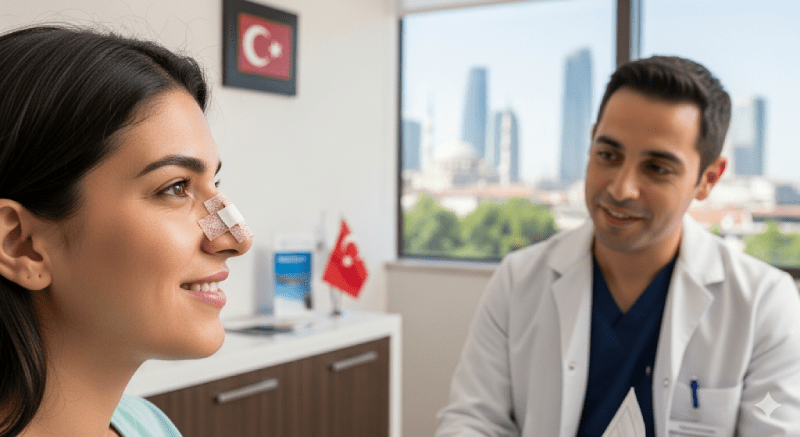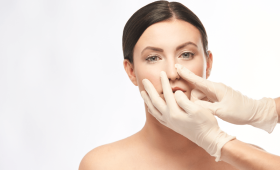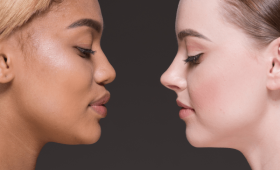What is Rhinoplasty?
Rhinoplasty, also known as a nose job, is a surgical procedure to change the shape of the nose or improve its function. This operation can be performed to address both aesthetic concerns and breathing problems. It is typically done to lift the tip of the nose, straighten the bridge, reduce the size of the nostrils, or correct nasal asymmetry. Rhinoplasty aims to make the nose, one of the most prominent features of the face, harmonious and aesthetically balanced with the other facial features. It is not just a physical change but can also be a significant step that enhances a person’s self-confidence and overall quality of life.
The History of Rhinoplasty
The history of nose surgery dates back to before modern medicine. The first records are found in the Sanskrit text Sushruta Samhita in India, dating back to the 6th century B.C. During that period, since nose cutting was a common form of punishment, a surgeon named Sushruta performed nose reconstruction using tissues taken from the forehead and cheeks. Although this knowledge was lost during the Middle Ages, it was revived in Italy during the Renaissance by Gaspare Tagliacozzi, who developed a technique for creating a nose from arm skin. In the 19th century, with the development of modern anesthesia and antiseptic techniques, rhinoplasty became a surgical procedure closer to its current form. In the 20th century, techniques were further refined, and rhinoplasty became one of the most popular fields of aesthetic surgery.
Types of Rhinoplasty
Rhinoplasty is divided into different types based on the surgical technique used.
- Open Rhinoplasty: In this technique, a small incision is made in the columella, the area between the nostrils. This incision gives the surgeon easier and more direct access to the nasal skeleton and cartilage structures. It is preferred for complex cases, nose tip shaping, or revision surgeries.
- Closed Rhinoplasty: In this technique, all incisions are made inside the nostrils. There is no visible external scar. It is used for more straightforward operations, such as minimal changes to the nasal tip or removing a hump from the bridge.
- Revision Rhinoplasty: This is a more complex procedure performed on patients who have had one or more previous nose surgeries. It aims to correct problems remaining from the previous operation.
- Septorhinoplasty: This operation corrects the curvature of the nasal septum (deviation) along with the nose aesthetics. It has both aesthetic and functional goals.
Aesthetic Rhinoplasty
Aesthetic rhinoplasty is performed to address a person’s dissatisfaction with the shape of their nose. These surgeries are carried out with goals such as straightening the nasal bridge, thinning or lifting the nasal tip, reducing the size of the nostrils, or correcting nasal deviations. The ultimate goal of the surgery is to achieve a natural and aesthetic nose that is in harmony with the other facial features. The patient’s expectations, the surgeon’s experience, and the surgical planning are of critical importance in this process. Aesthetic operations can contribute to an individual’s self-confidence and overall social and psychological well-being.
Functional Rhinoplasty (Septorhinoplasty)
Functional rhinoplasty, or septorhinoplasty, is performed to correct structural problems inside the nose, especially breathing problems. The most common cause is a deviated nasal septum. This deviation can make it difficult to breathe through one or both nostrils, leading to snoring, dry mouth, and recurrent problems like sinusitis. Septorhinoplasty surgery straightens the deviated septum and opens up the airway. This surgery is often performed in conjunction with aesthetic rhinoplasty, improving both respiratory function and giving the nose a more aesthetic appearance.
Who is a Suitable Candidate for Rhinoplasty?
The most suitable candidates for rhinoplasty are those who are physically and psychologically ready for the surgery.
- Reached physical maturity: The development of the nose and facial bones must be complete. This is usually around 16-17 years of age for girls and 17-18 for boys.
- Have realistic expectations: Individuals who aim to achieve a better nose that is in harmony with their facial features, rather than a “perfect” nose, achieve more successful results.
- Good general health: Individuals without serious chronic illnesses, who can stop smoking and drinking alcohol before and after the surgery, are suitable candidates.
- Experience aesthetic or functional discomfort: Individuals who are socially and psychologically distressed by the shape of their nose or who have breathing problems can be candidates.
- Be psychologically stable: Being mentally prepared for the changes and the recovery process is important.
Age Limit: When Should Rhinoplasty Be Done?
One of the most important physical conditions for rhinoplasty is that the nasal skeleton and cartilage structures have completed their development. This is necessary for the facial features to take their final shape. During adolescence, the nose is still growing and changing shape. Therefore, it is recommended to wait until around 16-17 years for girls and 17-18 years for boys. Early surgery can negatively affect nasal development and lead to the need for revision later in life. In rare cases, such as serious breathing problems or post-trauma deformities, surgery may be performed at an earlier age due to medical necessity.
Pre-Rhinoplasty Preparation Process
The pre-surgery preparation process is extremely important for a successful outcome and a smooth recovery.
- Doctor’s Examination: You should have a detailed consultation with your surgeon to evaluate your expectations, nasal structure, and general health condition.
- Health Checks: Blood tests and other necessary tests are performed to determine if you are a suitable candidate for surgery.
- Smoking and Alcohol Use: You must quit smoking and reduce alcohol consumption at least 2-3 weeks before the surgery. Smoking negatively affects the healing process and increases the risk of complications.
- Medication Use: Blood-thinning medications like aspirin and ibuprofen, as well as some herbal supplements, may need to be stopped before surgery. You should not use any medication without your doctor’s approval.
- Final Preparations: It is important not to wear makeup or jewelry on the day of the surgery and to wear comfortable clothes.
Why is Doctor Selection Important?
Rhinoplasty is a surgical procedure that requires great care and experience. The choice of doctor is the most critical factor for the success of the surgery and patient satisfaction.
- Experience and Expertise: A surgeon who specializes in aesthetic and functional nose surgery and has experience in this field should be preferred.
- Patient Relationship: It is very important that you can establish an open and honest communication with your doctor. You should choose a surgeon who understands your expectations, provides you with realistic information, and patiently answers all your questions.
- References and Results: Seeing the results of the doctor’s previous patients will give you an idea of the doctor’s style and abilities.
- A Well-Equipped Center: Having the surgery performed in a fully equipped and reliable hospital ensures preparedness for possible emergencies.
The Surgery Process: Anesthesia and Technique Determination
Rhinoplasty surgery is usually performed under general anesthesia and can take between 1.5 and 3 hours.
- Anesthesia: Most rhinoplasty surgeries are performed with general anesthesia, where the patient is completely asleep.
- Technique: The surgeon chooses either the open or closed rhinoplasty technique based on the patient’s nasal structure and the purpose of the surgery.
- Shaping: During the surgery, the nasal bone and cartilage structures are reshaped. If necessary, excess cartilage and bone tissue are removed or added. The septum is straightened to correct breathing problems.
- Finishing: After the nose is shaped, splints can be placed inside the nostrils, and a cast (plaster or plastic splint) is placed on the outside of the nose.
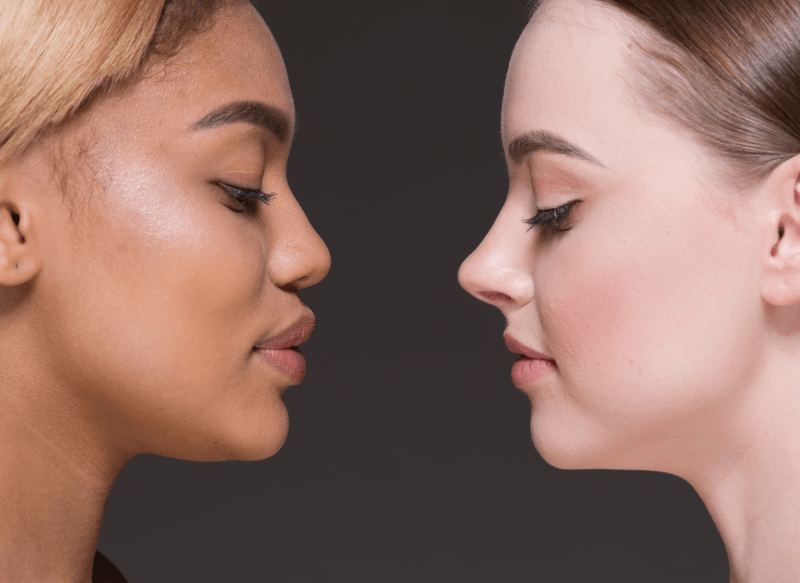
The First Days After Surgery
The first days after surgery are the most delicate phase of the recovery process.
- Swelling and Bruising: It is normal to have swelling and bruising around the nose and eyes. This condition increases within the first 24-48 hours after surgery and begins to decrease within a few days.
- Pain and Discomfort: There may be a mild pain and a feeling of fullness in the nose. This can be controlled with the painkillers prescribed by your doctor.
- Splint and Cast: The splints placed inside the nose are usually removed after 1-2 days. The cast on the nose is removed after a week.
- Rest: Bed rest is recommended for the first 24 hours after surgery. Sleeping with your head elevated helps reduce swelling.
The Recovery Process: Swelling and Bruising
The rhinoplasty recovery process is characterized by the gradual reduction of swelling and bruising.
- First Week: The cast and stitches on the nose are removed. The bruises on the face begin to turn yellow and decrease.
- First Month: Most of the major swelling on the nose goes down, but the tip of the nose may still be swollen. The facial features become more defined.
- 6 Months: The shape of the nose is largely settled, and its lines become clearer. A significant portion of the swelling at the tip of the nose also goes down.
- 1 Year: This is when full recovery and the final result are seen. The nose has completely settled and taken its final shape. Any permanent swelling in the nose has disappeared.
How Long Does Full Recovery Take?
The term “full recovery” in rhinoplasty means the nose has taken its final shape and all swelling has subsided. This process varies from person to person but usually takes up to a year. In the first month, about 60-70% of the nose’s final shape becomes apparent. The remaining 30-40% occurs gradually as the swelling, especially at the tip of the nose, goes down. It is very important to be patient during this process and follow your doctor’s recommendations. There is no need to rush for the final result.
Post-Surgery Care and Things to Note
Post-surgery care is vital to minimize the risk of complications and speed up the healing process.
- Head Elevation: Pay attention to keeping your head elevated during the first few days and nights while sleeping. This allows swelling to go down faster.
- Cold Application: Applying an ice pack around the eyes and nose during the first 48 hours helps reduce swelling and bruising.
- Cleaning: It is important to keep the nose area clean and use the sprays recommended by your doctor. Avoid excessive pressure when cleaning the nostrils.
- Protection from Bumps: The nose is very sensitive after surgery. You must absolutely avoid bumps and trauma.
- Eyeglass Use: You should avoid wearing glasses for at least 3 months after the surgery, as the pressure from the glasses on the bridge of the nose can cause the shape to deteriorate.
Post-Rhinoplasty Nutrition
Proper nutrition in the post-surgery period supports the body’s healing process.
- Fluid Intake: Drinking plenty of water is important to maintain hydration and help the body eliminate toxins.
- Soft Foods: Eating soft foods that do not require chewing for the first few days reduces pressure on the nasal area.
- Avoid Salt: Salt can cause fluid retention in the body. Therefore, avoiding salty foods during the recovery process is beneficial.
- Vitamin C: Vitamin C contributes to collagen production and speeds up tissue healing. Citrus fruits, kiwi, and leafy greens can be consumed.
- Protein: Protein is a fundamental building block for body repair. Sources of protein like eggs, chicken, and fish are important during the recovery process.
Returning to Sports and Physical Activity
Returning to sports and physical activities after rhinoplasty should be done carefully and gradually.
- First 2 Weeks: No physical activity should be performed other than complete rest and light walking.
- First 1 Month: You can start light-paced walking and non-strenuous exercises like yoga.
- 2-3 Months: You can start moderate-level sports like running and swimming. Activities that require high exertion, such as weightlifting, should be avoided.
- 6 Months and Beyond: Activities with a high risk of impact on the nose, such as contact sports, can only be resumed with a doctor’s approval.
Potential Risks and Complications of Rhinoplasty
As with any surgical procedure, rhinoplasty has potential risks and complications.
- Infection: Infection can rarely develop after surgery.
- Bleeding: There is a risk of excessive bleeding during or after the surgery.
- Anesthesia Complications: Anesthesia-related risks are always present.
- Numbness: A temporary feeling of numbness can occur at the tip of the nose or around it.
- Asymmetry and Shape Deformities: Asymmetry or undesirable results in the nasal shape can occur after the surgery. These conditions may require revision surgery.
- Breathing Problems: Permanent breathing difficulties can occur after the surgery.
Post-Rhinoplasty Changes: Psychological Effects
Rhinoplasty has significant psychological effects on an individual in addition to a physical change.
- Increased Self-Confidence: Most patients state that their self-confidence has increased because they have a better appearance after the surgery.
- Social Life: People who were shy in social settings because of their noses may become more comfortable and social after the surgery.
- Realistic Expectations: Having very high expectations before the surgery can lead to disappointment afterward. Therefore, it is important to keep expectations realistic.
- Emotional Swings: The swelling and bruising experienced during the recovery process can lead to temporary unhappiness or anxiety in some patients.
What is Revision Rhinoplasty and When is it Necessary?
Revision rhinoplasty is a secondary operation performed on patients who are not satisfied with the results of a previous nose surgery or who have experienced complications after surgery.
- Reasons: It is done for reasons such as undesirable aesthetic results (asymmetry, a droopy nasal tip, etc.), breathing problems, or the failure of the previous surgery.
- Timing: For revision surgery, the nasal tissues are expected to have completely healed. This process usually takes at least one year after the initial surgery.
- Difficulty: Revision rhinoplasty is more complex and requires more experience than the initial surgery because the surgeon has to work with existing scar tissue and altered anatomy.
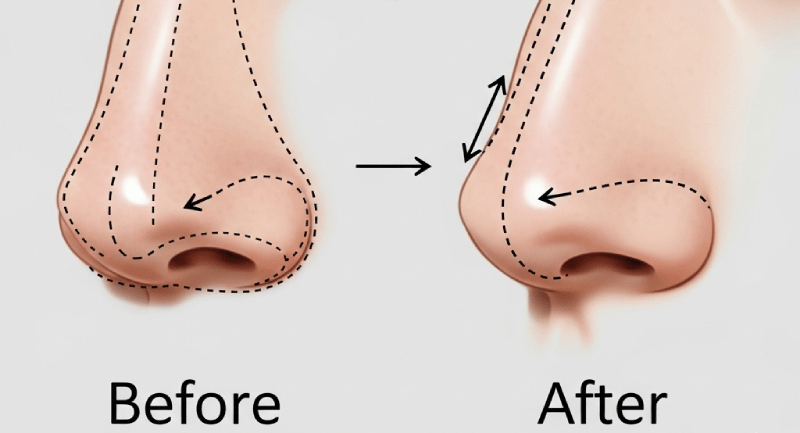
Rhinoplasty Costs and Factors Affecting the Price
Rhinoplasty prices vary depending on many different factors.
- Surgeon’s Experience: The prices of experienced and well-known surgeons are generally higher.
- Scope of the Surgery: Whether the surgery is only for aesthetic purposes or also includes a functional correction like septoplasty affects the price.
- Hospital Quality: The equipment and comfort of the hospital where the surgery will be performed also determine the cost.
- Geographical Location: Prices in major cities are generally higher.
- Additional Costs: Additional expenses such as anesthesia fees, hospital stay costs, post-operative check-ups, and medications should also be included in the total cost.
Non-Surgical Rhinoplasty Options
As an alternative to surgical operation, non-surgical rhinoplasty options are also available for minimal changes.
- Dermal Fillers: Small indentations on the nasal bridge or minor droopiness of the nasal tip can be corrected using fillers such as hyaluronic acid. This procedure is not permanent and usually needs to be repeated within 6-12 months.
- Botox: Botox can be used to lift the tip of the nose. This relaxes the muscles at the nasal tip, making the nose appear more elevated.
- Thread Lifting: Special threads can be used to lift the nasal tip or straighten the nasal bridge. These methods are less permanent than surgery and provide limited changes.
Rhinoplasty for Men
Rhinoplasty for men has different aesthetic goals than for women. Aesthetic nose surgery in men aims to achieve a stronger and more masculine appearance.
- Goals: Common goals include leaving a more defined nasal bridge instead of completely flattening the nasal hump, not lifting the nasal tip too much, and leaving the nasal angle wider.
- Skin Thickness: Men’s nasal skin is generally thicker, which can cause swelling to last longer after surgery.
- Expectations: It is important for male patients to also have realistic expectations and desire a nose that is in harmony with their facial features.
Natural-Looking Nose Aesthetics
One of the most sought-after results in rhinoplasty is a “natural-looking” nose.
- What It Means: A natural-looking nose is one that does not appear to have been operated on and provides an aesthetic harmony with the other facial features.
- Application: This result is achieved when the surgeon makes a personalized plan for the patient, considering their facial features, skin thickness, and ethnic characteristics.
- Nasal Functions: A natural-looking nose is not only aesthetically pleasing but also allows for healthy breathing.
Pre-Surgery Simulations and Managing Expectations
Modern rhinoplasty allows patients to see the potential results before the surgery.
- Simulation: Special software is used to simulate possible surgical outcomes on the patient’s existing nose photos in a computer environment.
- Purpose: These simulations help the surgeon better understand the patient’s expectations and provide the patient with a realistic idea of what the surgery can achieve.
- Importance: This stage strengthens the communication between the patient and the surgeon and ensures that both parties are focused on the same goal.
Conclusion: The Importance of the Rhinoplasty Decision and Consultation
The decision to have rhinoplasty is a personal one that should be made carefully. In this decision-making process, it is vital to obtain accurate information, choose a good doctor, and have realistic expectations. The results of the surgery have long-term effects, not only physically but also psychologically. Therefore, understanding all aspects of the operation and collaborating with an experienced and trusted surgeon who will guide you on this journey is the right approach. Remember, taking the right steps on this journey will lead you to a healthy and happy outcome.
